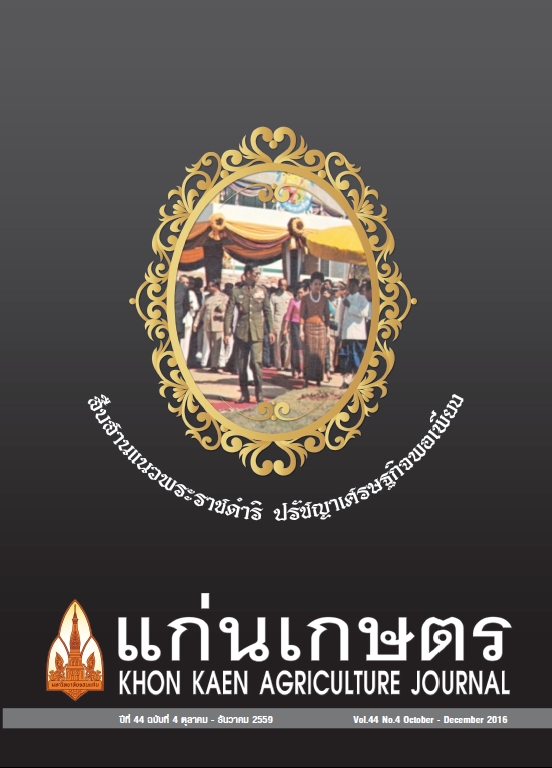สารสกัดจากเห็ดและประสิทธิภาพในการยับยั้งการเจริญของเชื้อราสาเหตุโรคพืชและแบคทีเรียบางชนิด
Main Article Content
บทคัดย่อ
การทดสอบฤทธิ์ของสารสกัดจากเห็ดในการยับยั้งการเจริญของเชื้อราสาเหตุโรคพืชและแบคทีเรียบางชนิด โดยใช้เห็ดทางการค้าและเห็ดที่ขึ้นตามธรรมชาติ ได้แก่ เห็ดนางรมฮังการี (Pleurotus ostreatus) เห็ดนางฟ้าภูฐาน (P. sajor-caju) เห็ดนางนวลสีชมพู (P. djamor) เห็ดเป๋าฮื้อ (P. cystidiosus) เห็ดตับเต่า (Boletus sp.) เห็ดฟาง (Volvariella volvacea) เห็ดแครง (Schizophyllum commune) เห็ดหลินจือ (Ganoderma lucidum) เห็ดออรินจิ (P. eryngii) เห็ดขอนขาว (Lentinus squarrosulas) และเห็ดไม่ทราบชนิด โดยใช้ น้ำกลั่น เอทานอล อะซิโตน และเฮกเซน เป็นตัวทำละลาย ทำการสกัดด้วยเครื่องกลั่นระเหยสุญญากาศและเก็บสารสกัดจากเห็ดที่ได้ที่อุณหภูมิ 4 °C ทำการทดสอบความสามารถในการยับยั้งการเจริญของเชื้อราสาเหตุโรคพืช 6 ชนิด ได้แก่ Fusarium oxysporum, Curvularia lunata, Alternaria brassicicola, Colletotrichum gloeosporioides, Sclerotium rolfsii และ Pythium sp. และแบคทีเรีย 3 ชนิด ได้แก่ Escherichia coli , Bacillus cereus และ Staphylococcus aureus ผลการทดสอบพบว่า สารสกัดจากเห็ดออรินจิที่สกัดด้วยน้ำกลั่นและเอทานอลมีฤทธิ์ยับยั้งการเจริญของเชื้อรา C. lunata, A. brassicicola และ C. gleosporioidesได้ดี โดยค่าความเข้มข้นของสารสกัดในระดับต่ำสุดที่สามารถยับยั้งการเจริญของเชื้อรา C. lunata , A. brassicicola และ C. gloeosporioides มีค่าน้อยกว่า 1.563 มก./มล. ส่วนสารสกัดจากเห็ดนางรมฮังการีที่สกัดด้วยอะซิโตนมีฤทธิ์ยับยั้งการเจริญของเชื้อแบคทีเรีย E. coli มีค่า MIC น้อยกว่า 170 มก./มล. และสารสกัดจากเห็ดนางรมฮังการีที่สกัดด้วยน้ำกลั่น เห็ดไม่ทราบชนิด ที่สกัดด้วยเอทานอลและอะซิโตน และสารสกัดจากเห็ดตับเต่าที่สกัดด้วยเอทานอล มีฤทธิ์ยับยั้งการเจริญของเชื้อแบคทีเรีย B. cereus มีค่า MIC น้อยกว่า 170, 190, 170 และ 150 มก./มล. ตามลำดับ ผลการทำทินเลเยอร์โครมาโตรกราฟีพบว่า สารสำคัญที่พบในสารสกัดที่สามารถยับยั้งการเจริญของเชื้อราสาเหตุโรคพืชได้ คือ สาร Protocatechuic acid
Article Details

อนุญาตภายใต้เงื่อนไข Creative Commons Attribution-NonCommercial-NoDerivatives 4.0 International License.
เอกสารอ้างอิง
Balakumar, R., E. Sivaprakasam, D. Kavith, S. Sridhar, and J.S. Kumar. 2011. Antibacterial and antifungal activity of fruit bodies of Phellinus mushroom extract. Int. J. Biosci. 1: 72-77.
Chen, J.T., and Huang J.W. 2010. Antimicrobial Activity of Edible Mushroom Culture Filtrates on Plant Pathogens. Plant Pathol. Bulletin. 19: 261-270.
Diker, K.S., M. Akan, M. Gulsenttascelik, and M. Yurdakok. 1991. Thebacteriocidal Activity of Tea against Camplyobacter jejuni and Camplyobacter coli. Appl. Microbiol. 12: 34-35.
Guler, P., I. Akata, and F. Kutluer. 2009. Antifungal activities of Fomitopsis pinicola (Sw.:Fr) Karst and Lactarius vellereus (Pers.) Afr. J. Biotech. 8: 3811-3813.
Johnny, L., U.Y. Kalsom, and R. Nulit. 2010. The effect of herbal plant extracts on the growth and sporulation of Colletotrichum gloeosporioides. J. Appl. Biosci. 34: 2218- 2224.
Jonathan, S.G., and F.E. Awotona. 2010. Studies on Antimicrobial Potentials of three Ganoderma species. Afr. J. Biomed. Res. 13: 133-139.
Kim, M.Y., P. Seguin, J.K. Ahn., J.J. Kim, S.C. Chun, E.H. Kim, S.H. Seo, E.Y. Kang, S.L. Kim, Y.J. Park., H.M. Ro, and I.M. Chung. 2008. Phenolic Compound Concentration and Antioxidant Activities of Edible and Medicinal Mushrooms from Korea. Agric. food chem. 56: 7265-7270.
Kopjar, M., V. Pilizota, D. Subaric, and J. Babic. 2009. Prevention of thermal degradation of red currant juice anthocyanins by phenolic compounds addition. Croat. J. Food Sci. Technol. 1: 24-30.
Mondal, T., R. Some, and S. Dutta. 2013. Studies on antioxidant and antimicrobial properties of some common mushrooms. JTBSRR. 2: 60-67.
Nehra, K., Meenakshi, M. Kumar, and A. Yadav. 2012. Evaluation of antimicrobial potential of fruiting body extracts of Pleurotus ostreatus (oyster mushroom). IJMRT. 1: 391-400.
Nunboon, J., P. Chotpraderm, K. Ruengruan, and P. Chomnawang. 2010. Effect of medicinal plant extracts and edible mushroom extracts in controlling leaf spot disease (Alternaria brassicicola) of cabbage seedling. P. 160-169. In: the 8th International Symposiium on Biocontrol and Biotechnology. P.4-6 October, Pattaya, Thailand.
Nwachukwu, E., and H.O. Uzoeto. 2010. Antimicrobial activity of some local mushrooms on pathogenic isolates. J. Med. Plant Res. 4: 2460-2465.
Pennerman, K.K., Y. Guohua, and W.B. Joan. 2015. Health Effects of Small Volatile Compounds from East Asian Medicinal Mushrooms. Mycobiology. 43: 9-13.
Tiwari, P., B. Kumar, M. Kaur, G. Kaur, and H. Kaur. 2011. Phytochemical screening and Extraction: A Review. IPS. 1: 98-106.
Turkoglu, A., P. Guler, A. Araz, F. Kutluer, and I. Kunduz. 2011. Antifungal Effects of Clitocybe odora (Bull.:Fr.) Kumm. Against The Plant Pathogen Fusarium culmorum and Fusariummoniliforme. Hacettepe. J. Biol. Chem. 39: 57-60.
Vaquero, M.J.R., M.R. Alberto, and M.C. Manca de Nadra. 2007. Antibacterial effect of phenolic compounds from different wines. Food Control. 18: 93-101.
Volf, I., I. Ignat, M. Neamtu, and V.I. Popa. 2014. Thermal stability, antioxidant activity, and photo-oxidation of natural polyphenols. Chem Pap. 68: 121-129.


